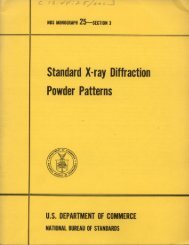Low Temperature Mechanical Properties Of Copper and Selected ...
Low Temperature Mechanical Properties Of Copper and Selected ...
Low Temperature Mechanical Properties Of Copper and Selected ...
Create successful ePaper yourself
Turn your PDF publications into a flip-book with our unique Google optimized e-Paper software.
<strong>Low</strong>-<strong>Temperature</strong> <strong>Mechanical</strong> <strong>Properties</strong> of <strong>Copper</strong> <strong>and</strong> <strong>Selected</strong><br />
<strong>Copper</strong> Alloys<br />
A Compilation From the Literature<br />
R. P. Reed <strong>and</strong> R. P. Mikesell<br />
In the past 60 years considerable data has accumulated concerning the mechanical properties<br />
of copper <strong>and</strong> its alloys. It was felt that there was a great need to adequately document these results<br />
in one publication. Therefore a unique type of compilation is presented. The compilation is divided<br />
into four parts. The first section is intended for quick reference use for those who are interested<br />
in average values. The second section includes data from most of the investigators who have pub<br />
lished results on the mechanical properties of copper <strong>and</strong> its alloys. The third section is composed<br />
of tables classifying the investigations which were not included in section two. These usually involve<br />
investigations in which data were obtained only at one temperature, such as room temperature. The<br />
fourth section lists, in alphabetical order, all references used.<br />
Key words: compilation, copper, copper alloys, low temperature, mechanical properties.<br />
Introduction<br />
In the past 60 years considerable data have been accumu<br />
lated concerning the mechanical properties of copper <strong>and</strong><br />
its alloys. Earlier investigations were primarily concerned<br />
with hardness, tensile strength, creep, <strong>and</strong> fatigue of copper<br />
at ambient temperatures <strong>and</strong> above. Gradually, with the<br />
introduction of new alloys <strong>and</strong> low temperature testing<br />
techniques, the scope of materials, temperature, <strong>and</strong> type<br />
of tests has broadened. However, it is not possible to find<br />
in one publication an adequate <strong>and</strong> thorough compilation<br />
concerning the mechanical properties of copper alloys.<br />
It was felt that the need for such a publication was great.<br />
With this in mind, we are grateful to the International<br />
<strong>Copper</strong> Research Association (INCRA) <strong>and</strong> to the <strong>Copper</strong><br />
Development Association for funding this compilation.<br />
The selection of the alloys was based on INCRA advice.<br />
They include pure copper plus some of the common solid<br />
solution copper alloys (copper-zinc, copper-nickel, copperaluminum)<br />
<strong>and</strong> some age-hardened alloys (aluminum<br />
bronzes, copper silicon, copper-zirconium). The only major<br />
alloy group which was omitted but perhaps should have<br />
been included is the copper-beryllium series. However,<br />
this group was included in the Cryogenic Materials Data<br />
H<strong>and</strong>book,* <strong>and</strong> the reader is advised to refer to this pub<br />
lication to obtain references <strong>and</strong> average properties for<br />
copper-beryllium alloys.<br />
The compilation is divided into four sections. Section I<br />
is intended for quick reference use for those who are inter<br />
ested in average values. Section II includes data from most<br />
of the investigators who have published results on the<br />
mechanical properties of copper <strong>and</strong> its alloys. Section III<br />
is composed of tables classifying the investigations which<br />
were not included in Section II. These usually involve<br />
investigations in which data were obtained only at one<br />
temperature, such as room temperature. Section IV lists,<br />
in alphabetical order, all references used in this compi<br />
lation. The preceeding paragraphs serve to document the<br />
procedures followed in this compilation.<br />
The average values, plotted on pages 2 to 13 are esti<br />
mated from the curves of Section II. Common material<br />
conditions for which data are available are included. How<br />
ever, in cases where it was thought that the data may not<br />
be representative or where only scattered, possibly unre<br />
liable data points are available, then that particular alloy<br />
or condition or temperature region was omitted.<br />
Section II includes all available mechanical property<br />
data for the selected alloys with two exceptions. If investi<br />
gators included only single temperature data (such as room<br />
temperature) <strong>and</strong> not time-dependent curves (such as stressstrain,<br />
fatigue, or creep) then the data were not included.<br />
Investigations of this nature which usually document trends<br />
©Obtained through <strong>Of</strong>fice of Technical Service*, U.S. Department of Commerce, Washington, D.C.,<br />
designated PB 171809.<br />
of tensile properties or hardness as a function of metal<br />
lurgical variables, such as grain size or irradiation, are<br />
listed in the tables of Section III. Some experimental data,<br />
particularly those obtained from single crystals, were not<br />
included in Section II. These data usually represent the<br />
results of flow stress, microstrain, or elastic constant<br />
experimental work. All references of Sections II <strong>and</strong> III<br />
are included in Section IV. In Section II the table adjacent<br />
to each graph lists all pertinent experimental <strong>and</strong> material<br />
information. If experimental or material details are omitted,<br />
it is because the information was not available in the<br />
reference. All individual temperature data points are plotted.<br />
However, the point at each temperature represents an<br />
average of the individual tests performed at the given<br />
temperature. Creep <strong>and</strong> fatigue curves for a given temper<br />
ature are average curves. Stress-strain curves were only<br />
included if the stress <strong>and</strong> strain were continuously recorded<br />
to fracture. Again, it seems appropriate to emphasize that<br />
if information is lacking on either the tables or the graphs,<br />
it may be assumed that the reference has failed to include it.<br />
Considerable effort was made to present all of the usable<br />
data from the literature. Articles as early as 1895 are in<br />
cluded. No data, regardless of its suspected reliability,<br />
were deliberately omitted. All temperature points are<br />
included even though some of them are probably in error.<br />
Great importance was placed in presenting all of the data<br />
in Section II, so that an informed observer could use his<br />
own discretion in evaluating the data. Part of the program<br />
sponsored by INCRA included tensile, notch tensile, <strong>and</strong><br />
elastic modulus tests from 300 to 4 K <strong>and</strong> impact tests<br />
from 300 to 20 K. The results of this test program are<br />
referenced in Section II under reference number 1.<br />
Many papers included reliable data on copper <strong>and</strong> its<br />
alloys which did not fall within the scope of the compilation.<br />
It was felt that these articles should be included in the bibli<br />
ography <strong>and</strong> somehow referenced. The tables in Section III<br />
are the result. By referral to these, the reader may note the<br />
articles in which specific tests have been performed on a<br />
given alloy series. It is thought that these reference tables<br />
will also be valuable to the reader in describing the various<br />
tests that have been performed on a specific alloy. Similarly,<br />
knowledge may be obtained regarding the investigations<br />
of specific metallurgical parameters (such as irradiation on<br />
a given alloy or alloy series). About 30 review papers are<br />
included in the references <strong>and</strong> are listed in the table on<br />
page 144. Discretion was used in choosing these papers,<br />
since many more exist in published form, particularly in<br />
trade journals. In a few cases, data were taken directly<br />
from a review paper, since the source of the data could not<br />
be adequately located nor referenced.<br />
Over 700 individual papers were examined <strong>and</strong> data were<br />
selected from the 465 references listed in Section IV. We

















